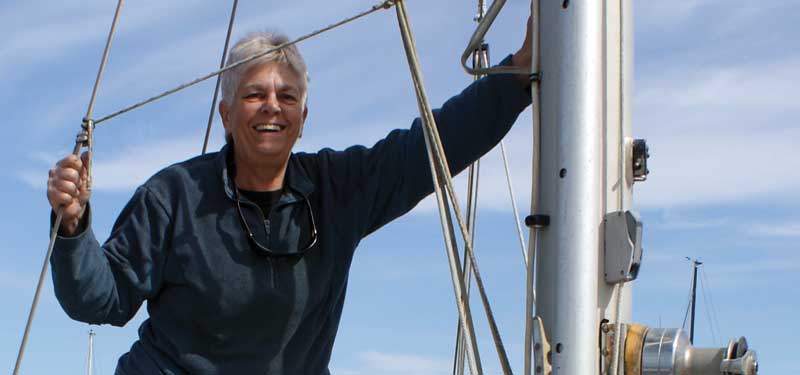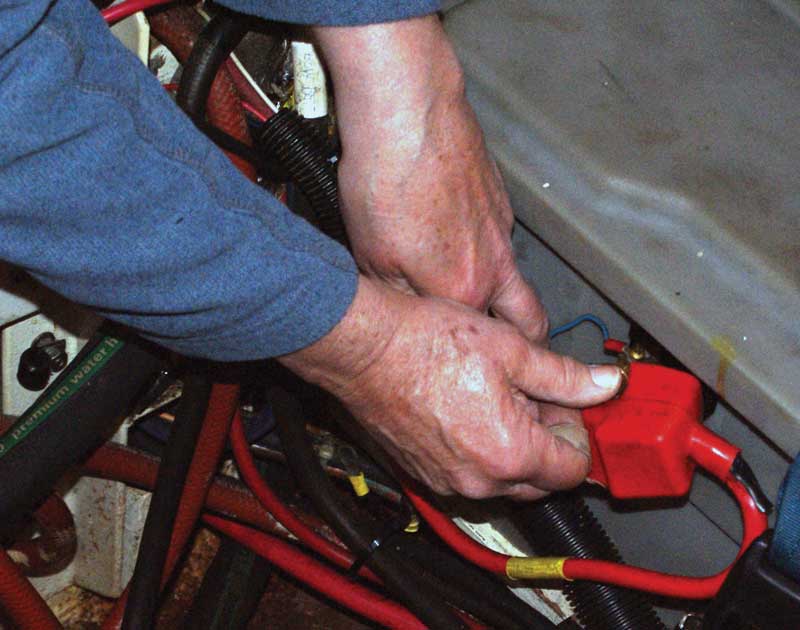Are you ready for spring commissioning? What does it involve? Should you do it yourself? What equipment do you need?

This year, we asked an experienced boater who’s good at maintaining recreational vessels. Priscilla Travis has been serving as her own mechanic on both powerboats and sailboats since the late 1970s. She now owns a 42-foot cutter that she’s maintained faithfully both here and in Europe.
Here are excerpts from an interview with Travis containing some advice on how to approach the annual spring commissioning rite: how to decide what to do, whether to do it yourself, and how to organize the whole thing so you don’t omit or overlook something (a frequent problem among do-it-yourselfers). Our checklist comes right after that.
Q. What should you try to accomplish in spring commissioning?
A. Three things: first, tend to things that you neglected to do or may have missed in the fall; second, make sure nothing has deteriorated over the winter; and third, get the boat ready for the new season so you can minimize the chances that something will go wrong when you’re out on the water. That means making sure all systems are ready to go.
Q. How good a mechanic do you have to be to do your own maintenance?
A. Think of it this way: a boat is a floating house. If you can’t do repair tasks around your house (i.e., you have to call a professional for even basic jobs), then you probably shouldn’t be doing more than simple maintenance on your boat. But if you like doing this kind of thing and you’re comfortable with mechanical tasks, you can get pretty good at it.
You also need to consider your own temperament. If you’re a “detail person” who’s a good observer and will be conscientious about following a checklist, you should be able to tackle the job yourself. If you’re not, you ought to consider letting a boatyard do the work. Be realistic about your skills and about your ability to learn new things.
Q. Where can you find the information you’ll need to prepare yourself?
A. The maintenance bible for boatowners is the “Boatowner’s Mechanical and Electrical Manual,” by Nigel Calder, which you can find online or at boating supply stores. You can get checklists by typing “boat commissioning” into your search engine (also at proptalk.com/spring). The important thing is to adjust the checklist to make it fit your boat.
Q. Isn’t that a lot of information to master in a short time?
A. You don’t have to try to do everything at once. Learn skills and build your knowledge gradually. If you have a technician work on your boat, ask if you can watch. You can learn a lot from observing a skilled mechanic or technician. You may decide that you can do some of those jobs yourself.
Q. What kind of tools will you need?
A. You don’t have to have a lot of tools but they have to fit the nuts, bolts, screw heads, engine parts, and fittings on your boat. Common hand tools, such as screwdrivers, socket and combination wrenches, pliers, and a hammer, will do, along with a few other tools that you’ll need to change the oil or fix specific equipment on your boat.
Ordinarily, you won’t need any power tools. If you tackle more complex jobs, you may need a few specialized tools, such as a prop-puller or torque wrench. Use quality tools. If you have metric fittings, make sure you bring tools that will fit them.
Q. What’s the best way to go about spring maintenance?
A. Do it systematically. Study the engine and other equipment manuals from the manufacturers. Besides changing the engine oil and filter (if you didn’t do it in the fall), checking belts, and looking for fluid leaks, check the batteries, plumbing and water systems, and electrical system. Check all hoses, including the head and holding tank.
Q. How long should it take to complete the job?
A. That depends on what kind of boat you have, how big it is, what systems it has, and how old it is. Assuming that there’s nothing wrong, it ought to take you between four and six hours. If you need to paint the bottom, that adds another few hours. And if you own a sailboat, you have to add time to bend on the sails and check or repair the rigging.
The larger and more complex your boat, the more you may have to rely on the services of a professional, and the more time it will take you to do even simple tasks yourself. Twin engines, a refrigerator/freezer, air-conditioning, a generator, a more complicated electrical system—all these require advanced technical knowledge.
You also need to consider that even if a job looks simple, you may not have much room to work. For example, if your engine room is small and cramped, a simple task such as changing an oil filter may take a lot longer than you anticipated—and may require some specialized tools.
Q. What else do you need to do to make sure you’re ready for the boating season?
A. Be sure to conduct a thorough shakedown cruise after you’ve finished. Take along another boater to drive so you can look around the whole boat while under way. Test everything you can, from your throttle and kill-switch to transmission controls and navigational electronics. Spend at least an hour under way. It’s better to discover problems now than to risk being surprised farther from port.
10 Spring Maintenance Items for Your Checklist
Be sure to adapt the list to fit your own boat:

1. Inspect the boat while she’s ashore.
See any fluid leaks around the engine or in the bilges? Have hose clamps or sea-cock handles come loose or fallen off? Has water entered anywhere below decks? Are ports and hatches secure? Are the batteries dry and properly connected? How about the hull? Stuffing-box tight? Need new zincs? Bottom paint?
2. After the boat’s in the water, check your batteries and engine.
Is the fuel in good condition? Do the fuel filters need to be changed? Oil level adequate—no leaks or drips? Transmission fluid at the proper level? Are belts correctly tensioned? Is the battery holding a charge? Are the terminals and wires clean and tight?
3. Start the engine and run it for half an hour or more, listening for sounds of trouble.
Giving it some run-time enables you to hear a lot of problems in the boat. It also gives the engine a chance to work off some of the moisture that may have collected there during the winter. And it helps charge your batteries.
4. If your boat is large enough to have electrical, mechanical, water, and waste systems, check them carefully, not just for a quick on-off test.
If you used potable water antifreeze in your water system last autumn, flush all the water tanks with clean water and let them overflow. Make sure your pumps work after having been dry all winter.
5. Next, what about your safety equipment?
Check your fire extinguishers, distress signals, air horn, loud-hailer, and other safety gear to make sure they’re working and not expired. And go through your first aid kit to check the condition of supplies and the expiration dates of any medicines you carry, and replace items that are no longer usable.
6. Don’t forget your compass, navigation lights, radar reflector, VHF-FM marine radio (and a handheld backup radio as well), and chartplotter.
And, if you have a boat trailer, give it the same careful scrutiny you’ve given your boat; look over the trailer hitch, safety chains, tires, bearings, lights, tie-down straps, and signs of rust.
7. Don’t stint, either on time or on money. Ensuring that your boat is properly maintained and equipped isn’t just a point of pride. It’s also a matter of safety—and possibly of life or death—if your boat encounters problems while you’re underway this coming summer. Take your time and do the job thoroughly and right.
8. Be sure to conduct a shakedown cruise (see Travis’s advice above).
9. If you have a sailboat, it’s good to get a rigging check every couple of years—from a professional rigger, if you have a larger boat—and be sure that he or she climbs the mast as part of the inspection. You should get a full report, including the condition of shrouds, stays, and chainplates. If there’s a problem, get it fixed immediately.
10. Finally, think back over what you’ve done and ask yourself whether you’ve fulfilled the basic objectives that Travis set out at the start: fixing whatever’s gone wrong during the winter and preparing the boat thoroughly to help reduce the risk of problems once the boating season begins.
About the Author: Art Pine is a Coast Guard-licensed captain and a longtime powerboater and sailor on the Chesapeake Bay.




